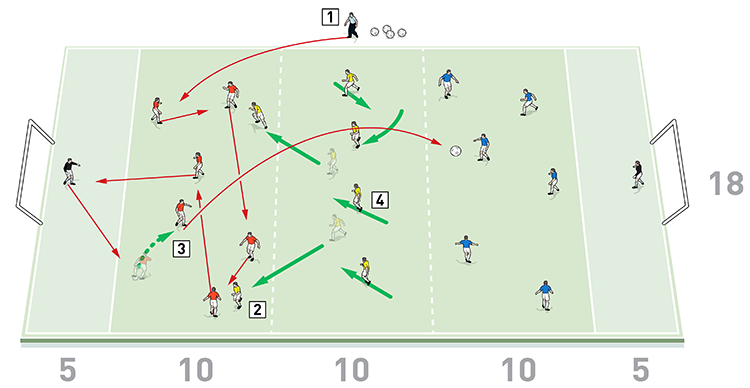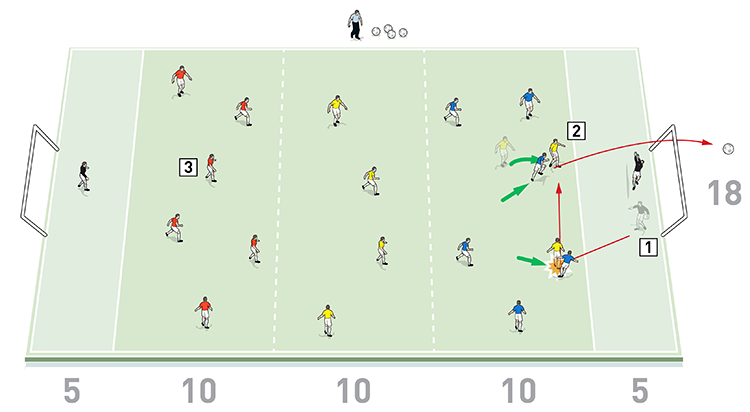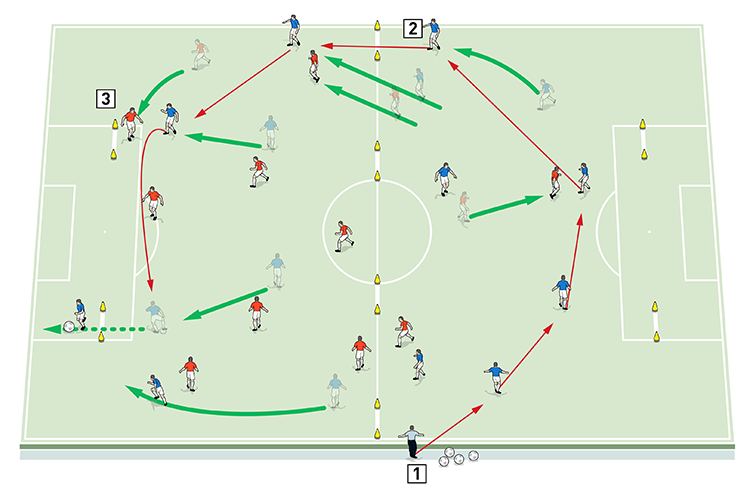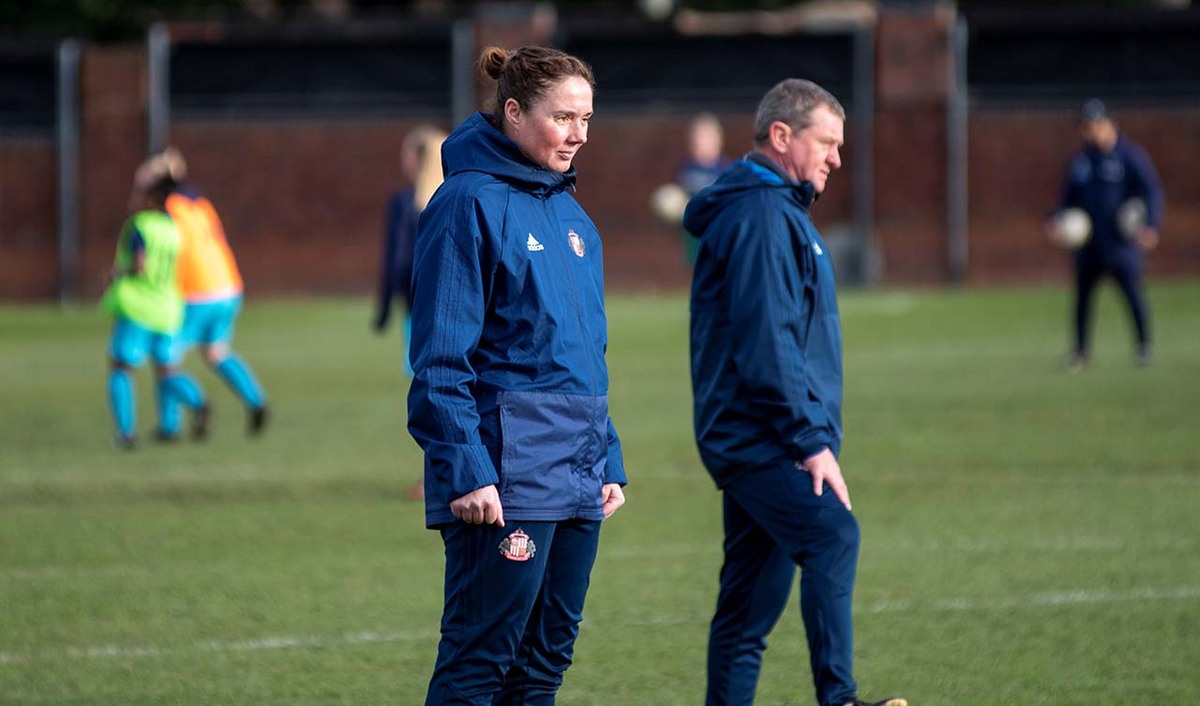




OUR BEST EVER OFFER - SAVE £100/$100
JOIN THE WORLD'S LEADING PROFESSIONAL DEVELOPMENT PROGRAMME
- 12 months membership of Elite Soccer
- Print copy of Elite Player & Coach Development
- Print copy of The Training Ground
Effective pressing
This session is all about getting the ball back as quickly as we can. We start with an activity focused on pressing in small groups to set the tone and then we move into pressing as a team, showing players when, where and how to do it.
| Area | Up to full pitch |
| Equipment | Balls, bibs, cones, 2 full-size goals |
| No. of Players | Up to 20 players + 2 goalkeepers |
| Session Time |
Warm up: 30mins, Go and press: 15mins, Pressing gates: 20mins, Game: 20mins |
This session is all about getting the ball back as quickly as we can. We start with an activity focused on pressing in small groups to set the tone and then we move into pressing as a team, showing players when, where and how to do it.
The players engage really well with this session because there’s always a reward for winning the ball back; if players regain possession they get to try and score a goal. That’s fundamentally what the game is all about.
When players are out of possession, this is a very high tempo session. The objective is to get the team as a whole to buy in to the aggressive press to ensure we don’t defend for long spells of the game.
This type of session isn’t one we would do every week but we would absolutely use elements of it on a regular basis. The first activity specifically deals with the techniques of passing, possession and shooting, which could all be a main focus of the session if necessary.
The players really seem to enjoy this session and it’s great for team building because they are all together being competitive against one another.
GO AND PRESS
We start with a warm-up [not shown]. Then we set up an area of 40x18 yards with a goal and a goalkeeper at each end. The main area of the pitch is divided into three 10-yard zones and each goal has an additional five-yard end zone in front of it for the goalkeepers.
We’re using 18 outfield players, split evenly into three teams of six. One team goes in each of the three 10-yard zones. The middle zone is for the defending team.
Play starts with the coach passing to a team in one of the outer zones. The receiving team must pass to keep possession under pressure from two defenders, who have been released from the central zone to press the ball.
The passing team can use the goalkeeper to help them keep possession if necessary and they must string six passes together before they can transfer the ball to the other possession team in the opposite outer zone, as shown [1a].
1a

2. Two defenders are released from the central zone to press the ball in the outer zone
3. The receiving team must pass to keep possession. Once they make six passes they can transfer the ball to the other end
4. The four defenders in the central zone remain compact and try to intercept through balls
The four defenders who remain in the central zone must stay alert and remain compact in order to screen for any through balls, blocking them if possible.
When the ball has been transferred, two more defenders can follow the ball to press it – they can
go as soon as it has been received in the opposite outer zone. The two original pressing defenders must return to the central zone at this point, as shown [1b].
1b

2. The two original pressing defenders must return to the central zone
3. The passing team must make six passes before they can transfer the ball back. They can use the keepers to help them keep possession
The passing team must again string six passes together before being allowed to transfer the ball back, but if the defenders gain possession they can immediately shoot at either goal, as shown [1c].
1c

2. If the defenders gain possession they can shoot at either goal but only the keepers are allowed in the five-yard end zones
3. The passing team at the other end must remain alert in case the ball is transferred back to them again
We play six two-minute games, rotating team roles every two minutes.
WHAT ARE THE KEY THINGS TO LOOK OUT FOR?
We want to see defenders remaining alert. Pressure should always be applied by the nearest player to the ball. Quick support by the covering player is also important so that the possession team is forced to play around the defence and not through it.
We want to see good communication from both of the pressing players and from the four defenders left behind, and when pressure results in a turnover of possession we want to see players remaining calm to ensure a solid shooting opportunity occurs, rather than players forcing play with a rushed shot.
We set up on a full size pitch with four six-yard cone gates on the halfway line and another two in each penalty area, as shown [2]. We are not using goals.
2

2. Teams try to score by dribbling or passing forward through the gates in the direction they are attacking
3. The attacking team cannot go through a gate if a defender is standing in front of it
We are using 20 outfield players split into two teams of ten. Play starts with a pass from the coach and the teams try to score by dribbling or passing through the gates. The game is directional, so teams can only score by going forwards through the gates. The attacking team cannot go through a gate if a defender is standing in front of it – this is the press.
Offsides apply so the defending team can work on the compactness and depth of the back line. The gates are situated in three different areas to give reference to the players’ positions. The two highest gates are for the forwards, the two deepest gates are for the defenders and the gates on the halfway line are for forwards, midfielders or defenders.
We run this activity for 20 minutes.
WHAT ARE THE KEY THINGS TO LOOK OUT FOR?
We want to see the nearest player to the ball pressing. We also need to see cover and support from players to the side, behind and in front.
It’s important that we see compactness from the units and good communication on the ball, around it and away from it.
My outcome for the session is to ensure players understand how to press within the team. The key information that should be given to the pressing players as a trigger is: in the attacking half the opposition should be shown inside, while in the defending half they should be shown outside.
WHAT ARE THE TYPICAL MISTAKES PLAYERS MIGHT MAKE AND HOW DO I AVOID THEM?
Typical mistakes made during the activity include players allowing the distances between the units to get too big, which then makes it easier for the attacking team to play forwards.
Compactness is important and if the forwards are pressing, then the defenders need to ensure they are not too deep. Another important thing to look out for is the role of the supporting defender; players are generally good at being the initial presser but the supporting player is sometimes too far away to make an impact on the initial press.
HOW WOULD I PUT THIS INTO A GAME SITUATION?
Using the same playing area as the previous activity, the cones now come out and the goals are set up at each end. The players would now compete in a game with normal rules [not shown].
With no reference points on the pitch, the players are guided by the first presser to ensure support and depth is correct. Communication is important and often players are a lot louder and more vocal than usual.
Related Files
Editor's Picks
Attacking transitions
Deep runs in the final third
Using the goalkeeper in build-up play
Intensive boxes drill with goals
Penetrating the final third
Creating and finishing
My philosophy
Pressing initiation
Compact team movement
Coaches' Testimonials

Alan Pardew

Arsène Wenger

Brendan Rodgers

Carlos Carvalhal

José Mourinho

Jürgen Klopp

Pep Guardiola

Roy Hodgson

Sir Alex Ferguson

Steven Gerrard
Coaches' Testimonials

Gerald Kearney, Downtown Las Vegas Soccer Club

Paul Butler, Florida, USA

Rick Shields, Springboro, USA

Tony Green, Pierrefonds Titans, Quebec, Canada
Join the world's leading coaches and managers and discover for yourself one of the best kept secrets in coaching. No other training tool on the planet is written or read by the calibre of names you’ll find in Elite Soccer.
In a recent survey 92% of subscribers said Elite Soccer makes them more confident, 89% said it makes them a more effective coach and 91% said it makes them more inspired.
Get Monthly Inspiration
All the latest techniques and approaches
Since 2010 Elite Soccer has given subscribers exclusive insight into the training ground practices of the world’s best coaches. Published in partnership with the League Managers Association we have unparalleled access to the leading lights in the English leagues, as well as a host of international managers.
Elite Soccer exclusively features sessions written by the coaches themselves. There are no observed sessions and no sessions “in the style of”, just first-hand advice delivered direct to you from the coach.







